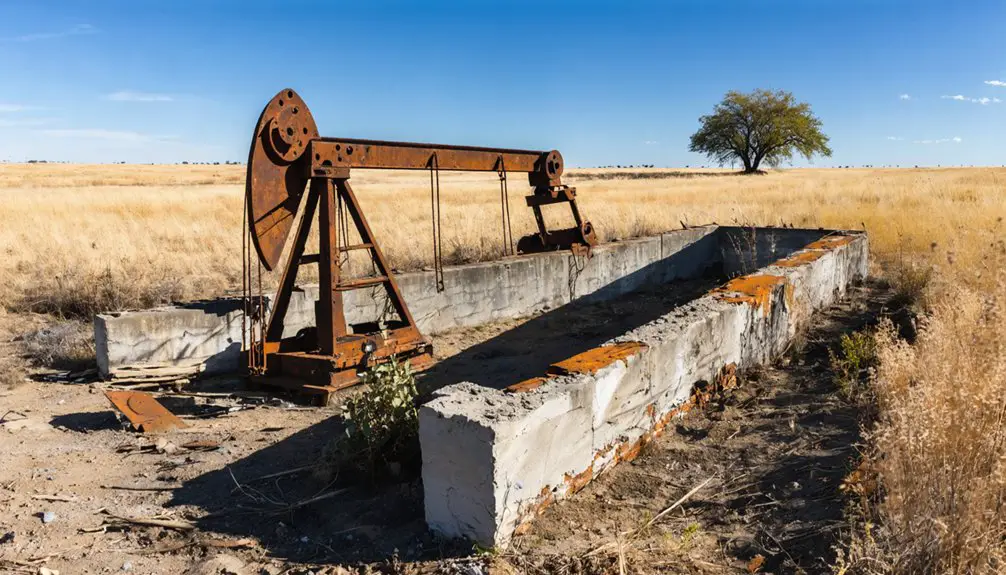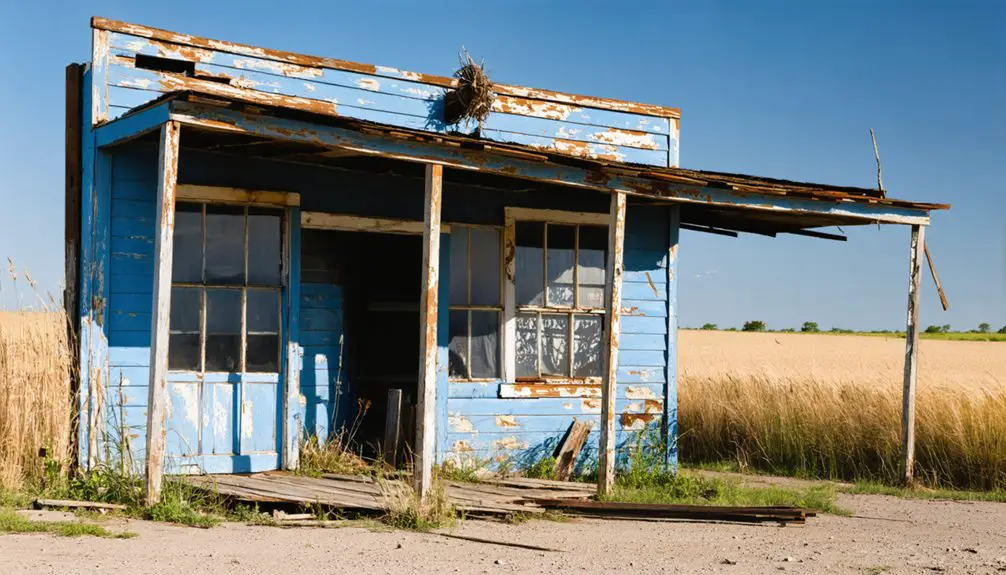You’ll find Hoxbar’s ghost town remains in Carter County, Oklahoma, where it emerged as a promising agricultural settlement in the early 1900s. After oil’s discovery, the town boomed with workers, families, and essential businesses. However, poor resource management, depleted oil wells, and isolation from major rail routes led to its decline. Today, you can explore deteriorating structures, abandoned homes, and concrete foundations that tell the story of this once-thriving community’s dramatic transformation.
Key Takeaways
- Hoxbar transformed from a thriving oil boomtown in early 1900s Oklahoma to a ghost town following resource depletion and economic decline.
- No permanent residents remain in Hoxbar today, with only deteriorating structures and concrete foundations marking its former existence.
- The town’s decline stemmed from isolation from major railroads, depleted oil wells, and agricultural challenges that forced population migration.
- Abandoned homes and service stations along former Route 66 showcase the architectural remains of Hoxbar’s once-vibrant community.
- Hoxbar represents a typical example of Oklahoma’s boom-and-bust cycle, influenced by oil discovery, agricultural shifts, and rural depopulation.
The Rise and Fall of Hoxbar
When oil was discovered in the early 20th century, Hoxbar emerged as a promising settlement straddling Carter, Humphreys, and Jackson counties in Oklahoma. The community dynamics quickly transformed as oil workers and their families flocked to the area, establishing a bustling town with post offices and essential businesses. Like many natural resource boomtowns, Hoxbar followed the pattern of rapid growth and eventual decline that characterized thousands of similar settlements across Oklahoma.
You’d have witnessed the town’s cultural heritage take shape around the oil industry, with supply stores and services springing up to support the growing population. Much like Webb City’s experience, the population peaked with the oil discovery and then declined.
However, as oil fields depleted and production declined, Hoxbar’s fortunes reversed. Businesses shuttered, and residents left in search of work elsewhere.
Without a railroad connection or highway access to sustain commerce, the town gradually changed into a semi-abandoned site, with its population dropping by more than 80% from its peak.
Life in Early Settlement Days
You’d find early Hoxbar settlers rising before dawn to tend their 160-acre homesteads, where they’d grow staple crops and raise livestock suited to the plains environment.
The isolation of scattered homesteads meant you’d rely heavily on basic log or sod structures for shelter, staying close to essential water sources like creeks and timbered bottomlands. Like the earlier Plains Apache tribes, homesteaders learned to adapt to the challenging conditions of the Southern Plains. The rich red clay soil of central Oklahoma provided fertile ground for their agricultural endeavors.
When the railroad expansion reached the area in the late 1880s, you’d see your community transform as coal mining operations near Hoxbar connected to the Wilburton and McAlester coalfields, bringing new economic opportunities and better access to supplies.
Pioneer Daily Routines
Life in early Hoxbar revolved around a demanding daily routine that began before sunrise and stretched well past sunset.
You’d start your day by stoking the hearth fire and fetching water from the well or windmill pump. Pioneer chores included tending to livestock, working the fields with basic tools, and maintaining your sod or timber home against harsh weather. Sod houses offered natural insulation against Oklahoma’s extreme temperatures.
Daily meals required careful planning, as you’d work with preserved foods and limited fresh ingredients. You’d prepare staples like bread, beans, and cornmeal in cast iron pots or Dutch ovens, supplementing with game meat when available. The recipes passed down through diverse settler groups brought their own unique cooking traditions to Oklahoma Territory.
Between agricultural work and home repairs, you’d join your neighbors for essential community activities like barn-raisings and quilting bees.
Despite the isolation, you’d find comfort in creating a personalized home space with handmade textiles and decorations.
Railroad Impact On Community
The arrival of railroads transformed Hoxbar’s development trajectory in the late 1800s, connecting the once-isolated settlement to essential regional networks. As railroad expansion reached the edges of Indian Territory, you’d find the town’s placement heavily influenced by the railway company’s station designations, which determined its economic prospects and growth potential. Similar to the Santa Fe Railway experience elsewhere, the rail company was poised to transport settlers and supplies efficiently to support the growing community. The Panic of 1893 brought challenges as railroad development slowed amid widespread bank failures and economic depression.
The rail lines didn’t just change Hoxbar’s physical landscape – they revolutionized community dynamics. You could witness dramatic reductions in travel time, making it easier to receive mail, goods, and news from neighboring regions.
The railroad station became your central hub for commerce and social interaction, where diverse populations would gather and conduct business. This accessibility attracted new residents and businesses, though it also meant significant changes for Native American communities who’d negotiated rights of way through their territories.
Economic Forces Behind the Exodus
You’ll find that Hoxbar’s fate was sealed by multiple economic blows, starting with its isolation from major railroad routes that left the town cut off from crucial trade networks.
The community’s agricultural foundation weakened as farming became less sustainable due to soil depletion and shifting market conditions in the region. Today, like many neglected sites, only scattered rubble and deteriorating structures remain as evidence of the once-thriving community.
When the oil boom that had temporarily revitalized the town went bust, leaving depleted wells and vanishing jobs, the exodus of residents became unstoppable. Like many of Oklahoma’s ghost town sites, Hoxbar now stands as a testament to the boom-and-bust cycles that shaped the state’s development.
Railroad Influence on Decline
While rail lines initially brought prosperity to Hoxbar during the early 1900s through the Missouri, Kansas, and Texas Railroad’s expansion into Indian Territory, these same transportation arteries would ultimately contribute to the town’s downfall.
The post-World War II era marked a turning point, as railroad expansion gave way to widespread service reductions. By 1965, Oklahoma’s rail network had shrunk dramatically to just 5,570 miles, severely impacting towns like Hoxbar that relied on rail connectivity.
You’ll find that this economic transformation hit particularly hard when newer highways bypassed the community, drawing traffic and commerce elsewhere. The double blow of reduced rail service and isolation from modern road networks left Hoxbar stranded, triggering business closures and a mass exodus that would eventually hollow out the town.
Agricultural Shifts Impact Communities
As mechanization swept through Oklahoma’s agricultural landscape in the mid-1900s, Hoxbar’s farming community experienced devastating economic shifts that accelerated its decline.
You’d have witnessed smaller family farms being swallowed up by larger operations, leading to significant rural depopulation as displaced farmers sought opportunities elsewhere.
The shift toward crop diversification couldn’t save Hoxbar’s agricultural base. As farming became more mechanized, fewer workers were needed to maintain the same acreage.
You’d have seen local grain elevators and equipment suppliers shuttering their doors as farmers began traveling to larger regional centers for their needs.
The aging population of remaining farmers, combined with their children’s exodus to urban areas, created a downward spiral. Without a new generation to take over family farms, Hoxbar’s agricultural foundation crumbled.
Resource Boom Gone Bust
During the early 1900s, Hoxbar emerged as a classic Oklahoma boomtown after the discovery of significant oil deposits in the region.
You’d have witnessed an explosive transformation as the town’s population surged, with oil workers, merchants, and speculators flooding in to stake their claims.
Poor resource management and a lack of economic diversification left Hoxbar vulnerable when the inevitable bust arrived.
When oil production declined and prices dropped during the Great Depression, you’d have seen the town’s fortunes reverse dramatically.
Businesses shuttered their doors, workers abandoned their homes, and the once-bustling streets emptied.
Without alternative industries to sustain the community, Hoxbar’s population plummeted.
The exodus left behind vacant buildings and deteriorating infrastructure, transforming the former boomtown into another Oklahoma ghost town.
What Remains Today

Once a bustling stop along historic Route 66, Hoxbar now stands as a silent collection of deteriorating structures and empty lots.
Today, you’ll find this ghost town frozen in time, marked by abandoned homes and service stations that line the former highway’s path. The architectural decay is evident everywhere – rusty signage hangs precariously, windows remain broken or boarded up, and roofs sag under years of neglect.
While nature steadily reclaims the land, concrete foundations stubbornly persist where buildings once stood.
No permanent residents remain, though occasional visitors pass through to observe the remnants. The town serves as a stark reminder of Oklahoma’s shifting economic tides, with its deteriorating motel and scattered empty plots telling the story of a community that time left behind.
Historical Significance in Oklahoma
While many Oklahoma ghost towns emerged from oil booms and mining operations, Hoxbar tells a different story of early 20th-century agricultural settlement in Carter County.
You’ll find its legacy deeply rooted in the community resilience of rural settlers who established essential trade networks and farming communities across the region.
Hoxbar’s transformation from a thriving agricultural hub to a semi-abandoned settlement mirrors broader patterns in Oklahoma’s cultural heritage.
The town’s decline reflects significant shifts in American rural life: the mechanization of farming, the consolidation of agricultural lands, and the exodus of younger generations to urban centers.
As transportation routes changed and local institutions closed, Hoxbar’s story became emblematic of countless small Oklahoma communities that once dotted the landscape, each contributing to the state’s rich tapestry of settlement and adaptation.
Preserving Hoxbar’s Legacy

As Oklahoma’s heritage sites face mounting preservation challenges, Hoxbar’s remaining legacy has become the focus of coordinated documentation and conservation efforts.
You’ll find dedicated academic researchers meticulously documenting the town’s history through fieldwork, photographs, and archival research at institutions like the University of Oklahoma’s Western History Collection.
Community involvement plays a significant role in preserving Hoxbar’s story. Through preservation techniques such as digital scanning of historical records and installation of informational markers, you can still connect with the town’s past.
Local museums and historical organizations have created exhibits highlighting Hoxbar’s significance, while online platforms enable sharing of historical data and photographs.
Despite challenges like vandalism and environmental hazards, these combined efforts guarantee that you’ll be able to explore and understand Hoxbar’s place in Oklahoma’s rich heritage.
Frequently Asked Questions
Are There Any Known Cemetery Sites or Burial Grounds in Hoxbar?
You’ll find Legate Cemetery as the main documented burial ground in Hoxbar, reflecting local cemetery history and burial practices. Find A Grave records confirm multiple grave sites in this area.
What Were the Population Numbers at Hoxbar’s Peak?
You’ll find peak population demographics reached approximately 3,000 residents during the mining boom about 100 years ago, making it one of thousands of Oklahoma towns that swelled rapidly before vanishing into history.
Did Any Notable Crimes or Significant Events Occur in Hoxbar?
You won’t find any documented notable crimes or significant events in Hoxbar’s history. Unlike other Oklahoma ghost towns with dramatic stories, Hoxbar remained relatively quiet throughout its existence.
Is It Legal to Visit and Explore Hoxbar’s Remaining Structures?
You’ll need explicit permission from current landowners before exploring any structures. Ghost town exploration here is subject to Oklahoma’s legal regulations on trespassing and property rights – don’t enter without authorization.
Were There Any Native American Settlements in the Area Before Hoxbar?
Like ancient footprints in shifting sands, you’ll find rich native history throughout this area, where Wichita, Creek, and other tribes established settlements long before Hoxbar’s existence, following traditional settlement patterns.
References
- https://en.wikipedia.org/wiki/List_of_ghost_towns_in_Oklahoma
- https://www.youtube.com/watch?v=-jYN1_E2VV0
- https://kids.kiddle.co/List_of_ghost_towns_in_Oklahoma
- https://www.youtube.com/watch?v=5NI-cU4nQ6w
- https://freepages.rootsweb.com/~gtusa/history/usa/ok.htm
- https://www.okhistory.org/publications/enc/entry?entry=GH002
- https://en.wikipedia.org/wiki/History_of_Oklahoma
- https://www.okhistory.org/publications/enc/entry?entry=SE024
- https://www.ebsco.com/research-starters/history/history-oklahoma
- https://en.wikipedia.org/wiki/Boomers_(Oklahoma_settlers)



